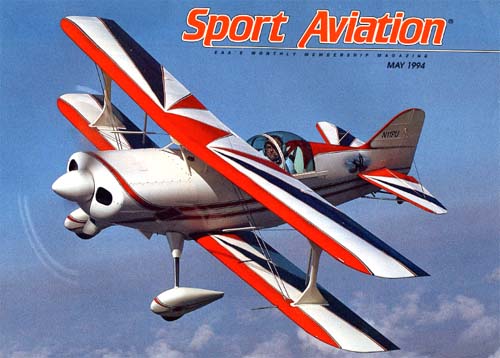
Budd Davisson, EAA/Sport Aviation, May 1994

Help me find an analogy here! How about, Van Gogh decides to paint another picture? Or maybe, Michael Angelo whittles up one more block of marble? How about Bach (Johann, not Richard) pens another little ditty?
They all apply in this case because an old master is an old master, whether the medium is paint, marble or music. Or aerobatic airplanes. In that field there is only one recognized old master, Curtis Pitts. And he has done it again. In spades! After a hiatus of over two decades he has just given us another master piece. He calls it Super Stinker.
I returned from Curtis's place in Homestead, Florida at 0100 hours this morning and I can honestly say I don't remember the last time an airplane kept me awake. At 0300 hours I was laying in bed staring at the ceiling, while my mind's eye watched that long nose whip around a totally blurred horizon, or hang effortlessly from an invisible moon, while I waited for it to get slow enough to hammerhead.
I also don't remember the last time I wanted to own an airplane as badly as I wanted to own that one. Actually, I do too remember. It was after flying the prototype S-2 Pitts.
Even in a field like sport aviation, where it seems a new generation of pilots pops up every three years who know nothing of what has gone before, there are certain standards of performance. In aerobatic airplanes, that standard is, and always has been, the Pitts Special. Even the newest, greenest convert to sport aviation knows that. Yes, in the unlimited arena, the leaders are now flying hot-rod monoplanes, but everywhere else, sportsman to advanced, the little Pitts Special still reigns supreme.
The actual leader in the unlimited category is money. A new unlimited mount that will let you butt heads with the top dogs starts at $150,000 and quickly works its way up to nearly $250,000. Homebuilders need not apply. Money is the primary language spoken here!
That's one of the reason's Curtis says he decided to dust off his drafting board and do it again. He wanted to design an unlimited category airplane the average homebuilder could screw together that, when combined with lots of talent and even more practice, would let him/her move within sight of those at the very top.
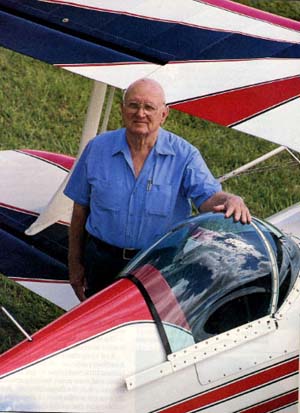 At this juncture, before everyone whips out their check
book and hunts up Curtis's address, we should mention that he
hasn't made up his mind what he's going to do with Super Stinker.
As this was being written, he stated he would very much like to
get back into the airplane building business and offer plans,
but was very leery of the liability problem. He wanted to enjoy
aviation, not wait for the next supeona, so he wasn't certain
he was going to make plans available for the airplane or not.
He said he'd make up his mind after Sun 'n Fun, so, by the time
you read this, we should have an answer.
At this juncture, before everyone whips out their check
book and hunts up Curtis's address, we should mention that he
hasn't made up his mind what he's going to do with Super Stinker.
As this was being written, he stated he would very much like to
get back into the airplane building business and offer plans,
but was very leery of the liability problem. He wanted to enjoy
aviation, not wait for the next supeona, so he wasn't certain
he was going to make plans available for the airplane or not.
He said he'd make up his mind after Sun 'n Fun, so, by the time
you read this, we should have an answer.
Super Stinker is the last in a long and distinguished line of excitable, three-dimensional skunks. It started with the original S-1 Pitts, the best known of which was Betty Skelton's 'Lil Stinker. The S-1's birth date was 1945. Then there was the first certified unlimited aerobatic biplane, the S-2. The prototype was named Big Stinker and it went into serial production as the S-2A with a 200 hp Lycoming and constant speed prop in 1971. Now, 23 years later, Curtis, with the help of some of the same friends that helped forge the Pitts Special into the aerobatic weapon it is, now has an entirely new airplane flying.
And you can take it from us, Super Stinker is some kind of hoss.
From the outside it would be easy to say Super Stinker, officially known in Pittsdom as the Model 11-260, is nothing but a scaled up S-1S with a 260 hp Aztec engine bolted to the front. Or is it a scaled down S-2B with the front pit removed?
Actually, it is none of the above. It is an entirely new airplane and it takes only a casual perusal of the airframe to see that. Starting with a clean sheet of paper, Curtis did a complete finite-element analysis aimed at letting the airplane safely survive the unlimited aerobatic category, where "G" limits are routinely ignored. His goals were strength and light weight coupled with several new innovations aimed at making the biplane competitive in a monoplane world. This included a new symmetrical aileron design, hinged well back, to give the roll performance all the new akro birds feature.
In terms of size it is closer to the single-hole airplanes than the two seaters. The upper span is 18 ft, which makes the span less than a foot longer than the S-1S/T series, but two feet shorter than the two-holers. The fuselage length is where the difference is most noticeable. It is nearly two feet longer than the little airplanes and just a foot shorter than the big ones.
The long, long nose puts the IO-540 well ahead of the firewall, so there is plenty of room behind it for any of the accessory variations seen with the different models of that engine. With the heavier engine that far ahead, it stands to reason the pilot would have be well behind. And he is. The resulting fuselage lines completely eliminate the stubby, pot-bellied bumble bee appearance so associated with Pitts Specials. It's a long, lanky dude and is pretty darned sexy looking.
There is another subtle difference that is most noticeable, when your feet work their way down under the panel, as your butt heads for the seat: You don't feel as if you're disappearing into an open manhole because the fuselage isn't nearly as deep as earlier airplanes. In fact, the cockpit is several inches wider and longer, which makes for a decidedly non-Pitts feeling to the flight deck. It is larger, very airy and cheerful feeling and fits exactly, precisely the way it should.
To a Pitts affecienado, its unnecessary to point out the decidedly non-Pitts wingtip and tail shapes. The wingtips are shaped the way they are to allow the ailerons to run as far out as possible for maximum effectiveness. The tail surfaces are angular, rather than being the gracefully rounded shapes associated with Pitts Specials. This is because, as Curtis put it, he didn't want to make the folks now building the certified Pitts Specials mad.
Come on Curtis, it needs a Pitts tail! Go for it! We'll protect you.
The spring gear, is another departure for a Pitts biplane, although the first S-2S models had it, but couldn't get certified because they wouldn't pass the drop tests. Most of the serious competitors now flying Pitts have converted their airplanes to spring gear for the lower drag. Curtis did the same on this one, for the same reason.
Most of Super Stinker's gestation period was conducted in secret. Few knew the Pitts skunkworks (now there is an apropos term) was about to give birth to another Stinker. Curtis, as everyone who knows him would agree, is very much a do it first and talk about it later type of person. He doesn't believe in hype. So there weren't any signal flares sent up letting the rest of sport aviation know what he was up to. Actually, Super Stinker would have been here earlier but Hurricane Andrew blew most of Pitt's shop facilities into Georgia and pretty well scrambled his life for a while. First things first.
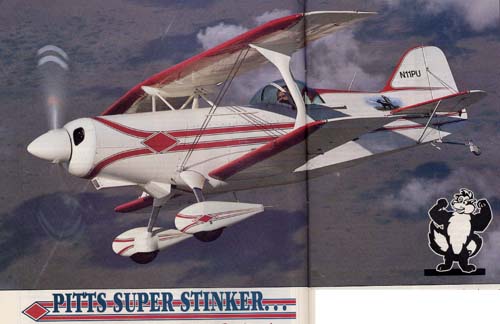
The old tin hangars on the tiny grass runway which had been home to several generations of Pitts Specials, practically disappeared in the hurricane. However, with the help of a lot of friends, they were replaced with much more substantial concrete structures. The concrete wasn't even dry and piles of soaked plans and memorabilia still littered the remaining office space, when progress of Super Stinker began anew.
Now it's finished and flying. And what is most astounding to me, personally, is that I was given the opportunity to fly it. It was one of the most flattering, and, as it turned out, most exciting opportunities of my life.
Curtis has a hard act to follow...himself. He not only has designed an airplane that is supposed to do akro combat against foreign airplanes using the best in space-age technology, but he has to follow in his own footsteps. His new airplane is undoubtedly going to be judged against everything he has ever done and it had to be more than just a good aerobatic airplane. It had to be the next logical step upward in the Pitts Special legacy. Having a pilot say, "...it's good, but..." wouldn't cut it. In unlimited competition, there is no room for "buts." It either is or isn't right.
All of that was going through my mind, as I stepped over the side and slid down into that relatively wide, comfy seat. I wanted desperately for Curtis to hit another homerun. But, I wouldn't lie to myself. And I wouldn't lie to him. The chips were going to fall where they may.
As I was strapping in, I had absolutely no feeling that I was strapping in to a Pitts. Not even a new one. The way the seat sits almost flat on the floor and the way the sheet metal stopped well down on my shoulders created a cockpit feeling that had practically nothing in common with any Pitts going before it. The instrument panel wasn't in my face and my legs were actually stretched a little further forward than I wanted. Although the cockpit fit me like a glove, I in no way felt shoehorned into it or crowded. I can't imagine any pilot being too big to fit. Since the rudder pedals are adjustable, I also can't imagine a pilot being too little. Curtis has learned a lot about cockpit design in the past few years and it shows.
The closest comparison to any other Pitts, in the way the cockpit feels might be the single place S-2S. But, Super Stinker has better visibility.
The nose that looks long from the outside, stretches on forever from the inside. It, however, isn't a factor of any kind. Sure, you can't see squat straight ahead, but visibility out to the sides is much better than something like an S-2A. In actuality, it is much better than most of the unlimited birds, including the Extra and Sukhois. It is also better than the One Design because it is so narrow, in comparison. With the nose out there like a magic wand, the pilot would have to be blind not to know what the airplane was doing. Or about to do.
The cockpit is rudimentary, although the center stack of radios
was an interesting addition. Not a lot of biplanes are so equipped
and practically no Pitts are. However, with the panel the size
it is, nothing was 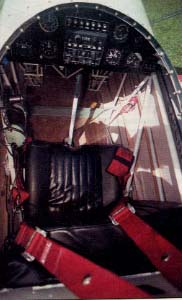 crowded.
crowded.
Before I jumped on a smoker and headed for Homestead, Curtis had primed me over the phone with all sort of little forewarnings; "...rolls faster than anything I've ever designed...You won't like the ailerons, they are so light....not an airplane for a casual pilot..." Then, after I got there, I heard some of the same things from his partners in building the airplane, Pat Ledford, Bill Lancaster and Don Lovern. Pat, in case you don't recognize the name is the guy who worked hardest on Curtis to put out plans for the single place in 1959-60. He built the first plans-built single place with Curtis doing the drawings while Pat was building the airplane. The same group is still cranking out airplanes together.
By the time the mag switch was twisted and the engine started to crank, adrenaline was pooling in my cowboy boots. I may not have been spooked, but I was certainly "attentive."
It's not hard to tell, when you've fire up a six, rather than a four cylinder Lycoming. The bark is still there, but the smoothness is hard to miss. It was also hard to miss the fact I was going to have problems with the brakes.
I should have adjusted the pedals in closer, because, when I went for the brakes my boots just slid up the pedal rather than mashing it down. Normally, this wouldn't have been a big deal, but the airplane had a locking Haigh tailwheel on it, so, when I was in close quarters and the tailwheel was unlocked, brakes were all I had to steer the airplane.
I rolled about 100 feet, felt like I was out of control of the situation and braked to a jerky halt, summoning Pat over as I did. Sliding the canopy back, I handed him my boots and socks and trundled merrily on my way barefooted, with my toes wrapped over the brake pedals.
Everyone has their own feelings about it, but, I'd put a regular steerable tailwheel on the airplane. On the other hand, the Haigh certainly takes a lot of sweat out of landing. The tailwheel lock was hooked to the stick like a late model T-6 or P-51: If the stick was anywhere except full forward, the tailwheel was locked straight ahead. It was a neat arrangement. With better shoes, I later found most of my steering problems went away.
As I rolled onto the centerline and sucked the stick into my lap, I couldn't help but grin a little. Actually, I was grinning a lot. The Lycoming was barking away up front and the edges of the 75' wide runway were clearly visible. The nose blocked everything ahead and the prop disk looked like it went most of the way out to the inter-plane struts. This was going to be fun!
My left hand started inching forward smoothly. I was being conservative because I had no idea what the airplane was going to do once 260 horses started trying to drag its 1100 pound airframe forward. But, the airplane obviously didn't want to be conservative. It was impatient and wanted to get with the program. And so did I.
The airplane hadn't rolled two hundred feet and the throttle wasn't half way forward, when I felt like I was home! This airplane wasn't going to do anything stupid! At least not anything I didn't ask it to do. So, I pushed the throttle to the stop and felt the nerve ends in my butt light up as the airplane slapped hard against them.
Tail up, I stared straight ahead at the nose and the bright blue sky beyond. I was letting my peripheral vision keep track of both sides of the runway at one time and signal my feet what was needed. Other than an occasional rudder pressure to the right, the airplane didn't ask for anything, as I kept pressuring the stick back in an effort to hold the slightly tail down attitude I wanted.
In much less time than it takes to talk about it, the airplane was off the ground. I had nothing to do with it. It just launched itself, as the Lycoming yanked me through the proper mixture of speed and angle of attack. The acceleration had unlocked the valves on my adrenaline pumps and I was in the process of getting an adrenaline high. But, nothing was scaring me. Nothing was even bordering on being out of the ordinary, it all fit together so well. It was all so, so smooth.
As I left the ground all of the comments about the aileron sensitivity were replaying themselves in my mind, so everything I had learned in every takeoff I had ever made crowded itself into that portion of my mind which controlled the stick. But it was unnecessary. The airplane was a bullet, a totally stable bullet that was cleaving a jagged hole through the slightly humid Florida air and needed no help from me.
Every nerve I had was sensing the control stick and the changing pressures, ready to yell at me to calm down and use less pressure, or less movement. But, this too was over-kill. The S-Stinker and I bashed through a few bits of turbulence, which gave me a golden opportunity to over control. But, it just wasn't there. The airplane immediately told me that if I moved, it would move. But, if I didn't do anything, it wouldn't either. We were totally connected.
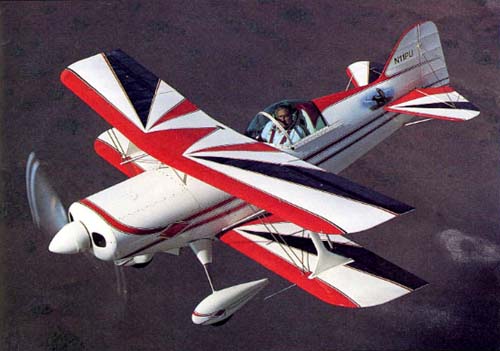
As the far end of the 3,000 foot runway flashed under me, the nose at a ridiculous angle, I glanced at the airspeed. 140 mph and the altimeter was winding up like a clock! Best rate was around 100 mph, but pulling the nose as high as I could, I never got the needle below 110. And we kept going up. And up.
I wasn't even out of the pattern and I was seriously in love. This wasn't just another airplane and I could already tell it. If I didn't do a single roll or loop, just what I had already sampled on the takeoff told me Curtis had once again worked his magic.
As I leveled off at 4,000 feet, I made a couple of quick turns and confirmed it: Super Stinker had that unique Pitts feel to it. It is an intangible feel, but one that is very definitely identifiable. Those who have flown both Eagles and S-2As, always comment on a subtle difference between the two seemingly identical airplanes. The Pitts has a softly "dense" feel to it, a term coined by test pilot Carl Pascarell to describe the feel. It goes past feeling solid, to some sort of difficult to define control feel that makes the pilot think the airplane is pushing against something solid every time it moves. It doesn't make any difference whether it is in normal flying or hard aerobatics, the airplane does everything in an authoritative way that greatly reduces the demands on the pilot to keep his flying crisp.
Take the way the airplane does point rolls for instance: In most ultra-hot aerobatic airplanes the first few times a pilot tries point rolls, he'll hit the points but there will be a little bobble as he works to figure out the ailerons to hold the point. Not so the Super Stinker. My first point rolls were on the backside of a Cuban-8. I did a four point on the first half and they were so clean and easy, I did a roll and a half with 8 points on the second half.
The important thing here is the point rolls were as clean and on target as I have ever done and I had less than 10 minutes in the airplane. Don't read this as me being a great pilot because I'm not. In the same situation with the One Design, Extras, etc., I would have been embarrassed to have anyone see my point rolls. But in the Super Stinker, I would have been ready to have them judged right then and there, they felt that good. The ailerons and the way the airplane behaves in rolling maneuvers are absolutely the best I've ever seen. The touch of The Master was showing through again.
Just about the first thing I did was diddle around with the roll rate. And boy does it have a roll rate! When I finally figured out how much rudder it needed, I was actually seeing something approaching visual gray-out just because the horizon was such a blur and it happened so fast. Only a week earlier I had been doing the same thing in the One Design, which designer Dan Rihn says they estimate at something over 400 degrees a second. If that's right, the Super Stinker is doing at least that.
As fast as it rolls, however, that same dense feeling works into it. The roll rate isn't noticeable until the ailerons are hammered fairly hard. The break-out pressures are actually quite a bit higher than they initially feel like, but the ailerons themselves are quite light. The net result is that there is absolutely none of the balanced on the head of a pin feeling. The airplane feels much larger and more stable than it has a right too.
There is no toy-airplane feel as there is with so many airplanes this size.
And then there are the snap rolls. Another surprise. A Pitts normally takes a little technique to get it started clean and even more technique to stop it clean. Not the Super Stinker. Just a little tweak on the stick, a stomp on the rudder and the world disappears for a second or so. A gentle rap of forward and opposite and the airplane stops on a dime with nine cents change. By the third snap, it telegraphed how it wanted to be snapped and I obliged. Another half hour snapping and I'd let those be judged.
One thing I have always been lousy at are vertical rolls. Even in my own airplane I'm not worth a damned. So, I was a little nervous as I sucked up into vertical with The 'Stinker. I thought I'd try a half roll first and see how it went. Bam! It was nearly flawless, as near as I could tell. The hammerhead after the roll was super sloppy, but the roll was good. Then a full one. Again, the wingtip tracked right around and stopped where I wanted. Amazing! The airplane was just too good to be true.
At one point, I was slow (an unusual situation in this airplane), so I closed the throttle and stomped full left rudder. It obliged me with a spin to the left. I watched it through three turns waiting for the nose to go the rest of the way down, but it never did. It looked to be much further off the vertical than most Pitts. But, when I stopped it, I was off heading because it stopped so quickly and so cleanly. Doing the same thing to the right, I just waited until my reference showed up and stomped rudder and nailed stick forward. It stopped dead right on the point. Amazing!
Everything I tried, the airplane made me look better than I really was. Rolling 360s, outside loops, snaps on the top, etc., etc. Every single thing I ask of it, it did with practically no technique from me and it did it cleanly. During my first snap on the top, for instance, I popped it while still a little nose high like I would in most airplanes and it completed the snap before I reached the top of the loop, stopping right on heading and wings level. What a hoot!
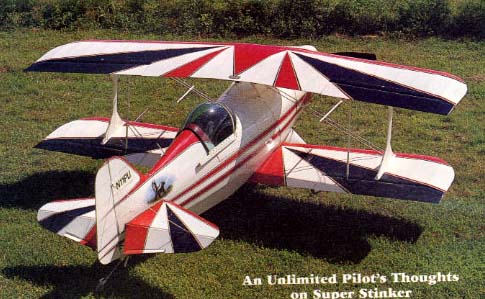
I did have a bunch of problems with the airplane, but all of them were pleasant problems. For one thing, the nose is well below the horizon in level flight, which is a new experience for a Pitts pilot. Consequently, I was constantly pulling the nose too high and I'd start at 3,000 feet and find myself at 6,000 feet without meaning too.
Secondly, the airplane is fast, really fast. At 24 inches square it indicates an accurate 181 mph (it does the same on a measured course) and will touch 200 at full power! Those are pretty wild numbers for a biplane! They are also much higher than I'm used to seeing, so I was constantly doing maneuvers well below the proper speed. Finally, I just stopped worrying about it, since the airplane didn't seem to care how fast it was going. I did loops as low as 120 mph and vertical rolled out of level flight and flew away.
We'd had a throttle linkage problem before takeoff so the friction lock wasn't working and the throttle would creep back, if I didn't keep pressure on it. But, that showed me another side of the airplane. I'd find I hadn't watched the throttle and it had crept back to 18 inches, but I was still indicating 160 mph at 4,000 feet!
Every first flight is nothing more than a prelude to the first landing, so my mouth is always a cotton patch until the first touch down. As I came into the pattern I was a little fast, about 150 mph, so on downwind I closed the throttle completely for a second. As that big old 81" Hartzell flattened out, I could feel myself being thrown into the straps. The speed was gone immediately and I made a metal note to remember during landing how much drag the prop adds.
I set up a downwind with the runway on the wing tip and closed the power oppose the numbers. My intention was to fly a standard, power-off 180 degree Pitts approach, with a belly check at the 90 degree point. The guys had told me to use 90 on short final and that's what I had showing. It took less than a second to realize the airplane was coming down a lot faster than most Pitts and, as the ground rushed up at me while curving onto the centerline, I began to doubt that it would flatten out in ground effect. So, I squeezed on just a little power and flew it into the flair.
Just a little power in this instance is about twice what is needed, so I gradually closed the throttle and felt for the ground. Following standard Pitts practice, I had my head back as far as possible, my peripheral vision working the edges of the runway. Clunk! The stiff spring gear and tailwheel hit at the same time and I kept my toes ready to grab brakes and rudder. My toes were disappointed, since the airplane streaked straight ahead, asking nothing of me to keep it straight. How much of that was the airplane and how much was the Haigh tailwheel I don't know, but it sure was straight.
A little voice inside my head shouted, Yee-Haw! The first landing was over and the nerve bundles could relax. This thing was a pussy cat on the runway! So, I straightened my left hand out again and launched back up into the pattern, this time clawing upwards at 110 mph right from rotation. As I blasted past the wind sock, I noticed what I felt was a creditable first landing had been made in a nearly 90 degree, 5-10 knot cross wind and I had barely noticed it.
I later found I could land, climb back up to 1,000 feet on downwind and land again and never get past the mid-point of a 3,000 foot runway. Not even on climb out. What an absolute blast!
I also found I could fly power off approaches okay, but had to carry an extra 5-10 mph across the fence to ensure the airplane flattening out and floating on ground effect. And then it floated too much. At anything under 90 mph power-off, it was sinking so fast, I don't think ground effect would slow its rate of descent enough to prevent a hard landing. In most approaches just enough power to keep the prop from flattening out would probably be wise. And then, when the power is killed, the pilot had better be ready to land because the prop will kill any speed he has left.
I'd have to say that my two short flights in Super Stinker were the most enjoyable and most informative flights I've made in the last fifteen years. They were enjoyable because the airplane could do no wrong. Whether I was aerobating it or landing, stalling or cruising, it was just about as nearly perfect as I thought an airplane could be. Granted it may not be the right mount for a GlassAir personality which rated utility above all, but I could certainly see adding another ten gallon tank to Super Stinker and using her for cross country work. When we were talking about what improvements the airplane needed, about the only think I could think to tell Curtis was, "It needs a different shaped tail, one that looks like a Pitts!"
But, don't think this is a Citabria pilot's airplane. It's not. While I think it is a much easier airplane to fly than most of the new aerobatic airplanes, it still does everything quite quickly. Including falling out of the air on final. An over-grossed S-2B on a 105 degree day would be a fair comparison. It would take some transition training, if a pilot had no high wing loading experience.
The flights were informative because they showed that in any artform a master's touch and style is easily identifiable. It's not hard, for instance, to tell a Van Gogh by the colors and brush stokes. It's even easier to tell a Pitts by the feel of the controls, the balance and the way it commands the air. That's what makes the difference between a master and a technician. The master infuses the work with something special, something that gives it texture and color beyond the norm. And that's Super Stinker. This is a very, very special airplane and it's not by coincidence that it's first name is Pitts.
If plans become available, the line forms behind me. BD